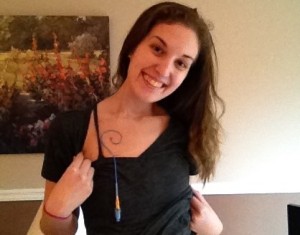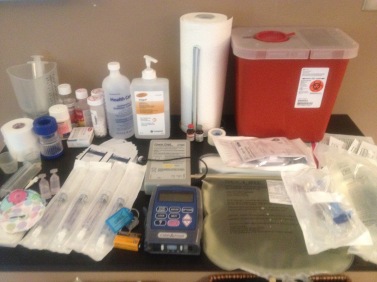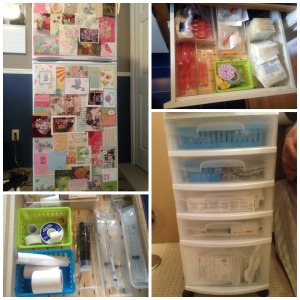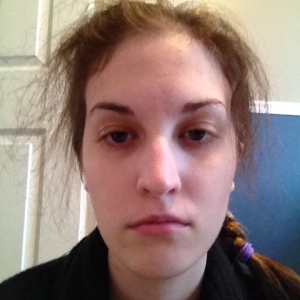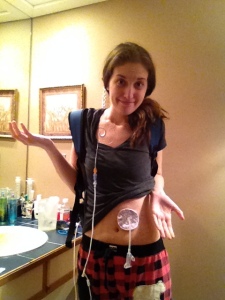When I was in the hospital last September a lot of people there were very curious about the whole not eating thing and I got a lot of questions about it…my favourite/the most ridiculous being, “but have you ever tried eating anything?” I decided to blog about this topic, and I even asked if any of you had any questions about it over on my Facebook page, and then no post ever appeared.
Here’s the thing. It’s not that I forgot, it’s that when I started writing there was just SO much to say and I had a really hard time concisely explaining it all. But what better time than Feeding Tube Awareness Week to finally put into words what it’s like not being able to eat. Because there’s so much to say, I’m doing this in two parts.
Up first? The facts.
Disclaimer: this is just my point of view. I can’t speak for anyone else because every person experiences and reacts to things in their own way.
Alright. So, I have gastroparesis secondary to Ehlers-Danlos Syndrome. Without getting into too much detail, partly because it’s not all that exciting and partly because science doesn’t even know all the ins and outs yet, faulty connective tissue impairs my digestive tract’s ability to function properly and so my stomach and intestines don’t move food along efficiently.
Question: Are you allowed to eat?
Yes. There is nothing or no one physically stopping me from eating. I can swallow safely (though pills do have a tendency to get stuck in my throat and start to disintegrate there…ouch) and my doctors encourage me to eat when I can to maintain as much gut function as possible. However, the consequences of eating can be brutal.
Question: What happens when you eat?
Bad things. Next question…
Hah, no but in all seriousness bad things happen when I eat. Nausea is my biggest battle in life. I am constantly nauseated to some degree, but add eating and drinking to the mix, even small amounts, and my nausea gets kicked up a notch or two…or fifty. I have four different nausea medications on hand, but they don’t work miracles, they just take the edge off.
I get full very quickly. Just taking a couple of pills can make me full. The technical name for this is early satiety. And I don’t mean wow-that-was-a-satisfying-dinner-but-now-I-don’t-want-to-eat-anymore full, I mean I-can’t-believe-I-ate-all-that-what-was-I-thinking-wow-I-feel-so-so-sick-now full. In addition to the nausea, this early satiety comes with a lot of other symptoms such as bloating, abdominal pain, gas and reflux. I have a lot of chest and throat pain from reflux, and it’s not very lady-in-waiting-like of me but I love burping. Ew, right? Yeah well, let me tell you, when you’re so full and uncomfortable to the point of gagging and crying, relieving some of that pressure is magical. Keep in mind that because my stomach empties slowly these symptoms can stick around for hours.
Question: So what do you eat then?
Not much. Saltines. I can usually eat two or three saltines a day. I can drink maybe 100 to 200 mL of fluid day? Maybe. And not all in one sitting because that would be bad news bears.

Lifesaver rolls in bulk. Thanks Amazon.
It takes me an entire day to drink that much, and a lot of that is just from taking meds. I also eat a small amount of fruit sorbet, a spoonful or two several times a week. We buy it from the gelato place near my house so it’s delicious but I do have to be careful as most of the flavors I like cause reflux. And then I can eat a few orange tic tacs, lifesavers or jolly ranchers here and there. Not exactly a good-for-the-teeth diet, but I work really hard to compensate for this and luckily I have a very understanding dentist who doesn’t shame me for eating candy.
Besides a tiny taste of things now and again, that’s basically all I eat. And even those things give me symptoms, sometimes really terrible symptoms, but not eating anything at all is also terrible, just in a different way, so it’s a balance.
Question: Do you feel hungry?
I don’t really get hungry, no. That growling stomach? Those hunger pangs? Those rarely happen to me anymore. I’m not an expert on the physiology of hunger and digestion, but I know that while part of hunger and satiety comes from stretch receptors and signals throughout the GI tract, part of it comes from levels of nutrients in the bloodstream. Because I’m still getting all the nutrients I need from my TPN, my body has no physiological need for food, which is what hunger is. Once in a while I will feel a small sensation of, “I think I’d like some food please,” from my stomach but when that happens it’s usually a trick! As soon as I feed it my stomach says, “Oh hold up I’m remembering that I actually don’t like food…sorry.” Sometimes I also experience that I-feel-nauseous-but-I-think-it’s-because-I-need-to-eat feeling. Also a trick.
Fun fact: my friend Leah and I frequently text each other “GTAF” which stands for Got Tricked Ate Food. It happens often enough that we have shorthand for it.
Question: Do you feel full?
Yes! I feel full pretty much all the time. Sometimes it’s just that I feel no need to eat, and sometimes I feel like I just ate even though I didn’t. And then of course when I do eat or drink anything, as I already described, that feeling of fullness reaches a miserable level.
Question: Do you get cravings?
Yes. Oh my goodness, yes! I just talked about hunger and fullness, but another pivotal player here is appetite, which is the desire to eat. I find appetite incredibly fascinating because even when I’m nauseated I still sometimes find myself wanting food despite the fact that it almost always ends badly. Oh and here’s another little fun fact for you. PMS cravings? Real. 100% real. Ladies, take it from someone who can’t eat and doesn’t even like chocolate that much, that chocolate craving you cannot ignore is legitimate.

Shhhh. Hoping no one catches me browsing the fridge.
When it comes to resisting food cravings, I find placement is key. If I open the fridge and see grapes (my all-time favourite food) front and centre then I am going to have a hard time resisting them, however if they are buried in the crisper then they’re easier to ignore. Ease of access is another important factor. If I have to take a lid off of a container or rearrange things in the cupboard to get to something then I’m less likely to make the effort. As well, the longer it takes for me to get to a food, the more time I have for reason and self-control to kick in. Sometimes, though, I straight up have to get my mom to hide food from me. Like pretzels. I will probably still go looking for them but luckily she is very inventive when it comes to hiding spots.
Okay now, brace yourselves or skip to the end, because the last thing I’m going to talk about here is poop. Not mine specifically! Yikes. Just in general.
Question: Do you still poop?
You have no idea how many times I have been asked this question! If my life were a drinking game I would take a shot (do a shot?…have a shot?…drink a shot?…can you tell I’ve been sick the entire time I’ve been legal?) every time someone awkwardly asked me this question while trying not to be awkward. Here are some variations: So um, if you don’t eat anything, do you uh…? If your stomach doesn’t empty properly how do you, well, you know…? I know you’re not really putting anything into you sooo does um, does anything, um, come out of you?
This question honestly doesn’t bother me because let’s face it, if I wasn’t living it I would be curious, too! The answer is yes. Even when you don’t eat your body still produces and secretes digestive juices into your GI tract and not everything gets reabsorbed. Your body also uses your GI tract to get rid of other wastes such as bacteria and old cell components. So yup, there is still some stuff to get rid of. The reality for those of us with chronic GI disorders is that we spend way more time than we would like thinking and talking about poop, to the point that we lose all concept of TMI, but for the sake of the rest of you, I’ll just leave it here!
And there you have it. Those are some of the facts about my life without food. Tomorrow I’ll be back with part two: the feelings.
Stay tuned!

